The intercalated nuclear complex of the primate amygdala
- PMID: 27256508
- PMCID: PMC4928580
- DOI: 10.1016/j.neuroscience.2016.05.052
The intercalated nuclear complex of the primate amygdala
Abstract
The organization of the inhibitory intercalated cell masses (IM) of the primate amygdala is largely unknown despite their key role in emotional processes. We studied the structural, topographic, neurochemical and intrinsic connectional features of IM neurons in the rhesus monkey brain. We found that the intercalated neurons are not confined to discrete cell clusters, but form a neuronal net that is interposed between the basal nuclei and extends to the dorsally located anterior, central, and medial nuclei of the amygdala. Unlike the IM in rodents, which are prominent in the anterior half of the amygdala, the primate inhibitory net stretched throughout the antero-posterior axis of the amygdala, and was most prominent in the central and posterior extent of the amygdala. There were two morphologic types of intercalated neurons: spiny and aspiny. Spiny neurons were the most abundant; their somata were small or medium size, round or elongated, and their dendritic trees were round or bipolar, depending on location. The aspiny neurons were on average slightly larger and had varicose dendrites with no spines. There were three non-overlapping neurochemical populations of IM neurons, in descending order of abundance: (1) Spiny neurons that were positive for the striatal associated dopamine- and cAMP-regulated phosphoprotein (DARPP-32+); (2) Aspiny neurons that expressed the calcium-binding protein calbindin (CB+); and (3) Aspiny neurons that expressed nitric oxide synthase (NOS+). The unique combinations of structural and neurochemical features of the three classes of IM neurons suggest different physiological properties and function. The three types of IM neurons were intermingled and likely interconnected in distinct ways, and were innervated by intrinsic neurons within the amygdala, or by external sources, in pathways that underlie fear conditioning and anxiety.
Keywords: anxiety; connectivity; emotion; inhibition; medium spiny; quantitative anatomy.
Copyright © 2016 IBRO. Published by Elsevier Ltd. All rights reserved.
Figures
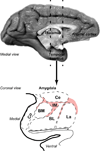
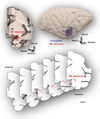
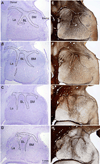
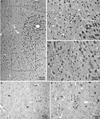
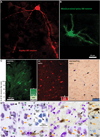

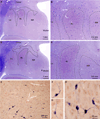
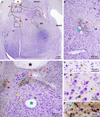
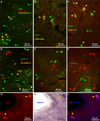
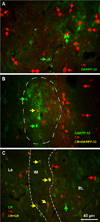
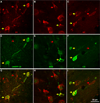
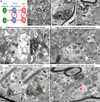

Similar articles
-
Posterior Orbitofrontal and Anterior Cingulate Pathways to the Amygdala Target Inhibitory and Excitatory Systems with Opposite Functions.J Neurosci. 2017 May 17;37(20):5051-5064. doi: 10.1523/JNEUROSCI.3940-16.2017. Epub 2017 Apr 14. J Neurosci. 2017. PMID: 28411274 Free PMC article.
-
The intercalated cells of the amygdala.J Comp Neurol. 1986 May 8;247(2):246-71. doi: 10.1002/cne.902470209. J Comp Neurol. 1986. PMID: 2424941
-
Functional connectivity of the main intercalated nucleus of the mouse amygdala.J Physiol. 2011 Apr 15;589(Pt 8):1911-25. doi: 10.1113/jphysiol.2010.201475. Epub 2011 Jan 10. J Physiol. 2011. PMID: 21224220 Free PMC article.
-
The intercalated paracapsular islands as a module for integration of signals regulating anxiety in the amygdala.Brain Res. 2012 Oct 2;1476:211-34. doi: 10.1016/j.brainres.2012.03.047. Epub 2012 Mar 27. Brain Res. 2012. PMID: 22516107 Review.
-
GABAergic neurons: gate masters of the amygdala, mastered by dopamine.Neuron. 2005 Dec 22;48(6):877-9. doi: 10.1016/j.neuron.2005.12.002. Neuron. 2005. PMID: 16364892 Review.
Cited by
-
The role of the amygdala in processing social and affective touch.Curr Opin Behav Sci. 2022 Feb;43:46-53. doi: 10.1016/j.cobeha.2021.08.004. Epub 2021 Sep 1. Curr Opin Behav Sci. 2022. PMID: 35602667 Free PMC article.
-
Immature excitatory neurons develop during adolescence in the human amygdala.Nat Commun. 2019 Jun 21;10(1):2748. doi: 10.1038/s41467-019-10765-1. Nat Commun. 2019. PMID: 31227709 Free PMC article.
-
Postnatal development and maturation of layer 1 in the lateral prefrontal cortex and its disruption in autism.Acta Neuropathol Commun. 2019 Mar 13;7(1):40. doi: 10.1186/s40478-019-0684-8. Acta Neuropathol Commun. 2019. PMID: 30867066 Free PMC article.
-
Rehydration of Freeze Substituted Brain Tissue for Pre-embedding Immunoelectron Microscopy.Microsc Microanal. 2023 Sep 29;29(5):1694-1704. doi: 10.1093/micmic/ozad077. Microsc Microanal. 2023. PMID: 37584524 Free PMC article.
-
Mirror trends of plasticity and stability indicators in primate prefrontal cortex.Eur J Neurosci. 2017 Oct;46(8):2392-2405. doi: 10.1111/ejn.13706. Epub 2017 Oct 4. Eur J Neurosci. 2017. PMID: 28921934 Free PMC article.
References
-
- Amaral DG, Price JL, Pitkanen A, Carmichael ST. The Amygdala: neurobiological aspects of emotion, memory, and mental dysfunction. New York: Wiley-Liss; 1992.
-
- Anderson KD, Reiner A. Immunohistochemical localization of DARPP-32 in striatal projection neurons and striatal interneurons: implications for the localization of D1-like dopamine receptors on different types of striatal neurons. Brain Res. 1991;568:235–243. - PubMed
-
- Asan E. Ultrastructural features of tyrosine-hydroxylase-immunoreactive afferents and their targets in the rat amygdala. Cell Tissue Res. 1997;288:449–469. - PubMed
Publication types
MeSH terms
Substances
Grants and funding
LinkOut - more resources
Full Text Sources
Other Literature Sources

